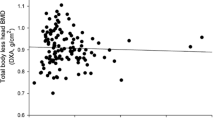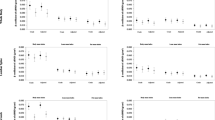Abstract
Summary
Longitudinal relationships between adiposity (total body and central) and bone development were assessed in young girls. Total body and android fat masses were positively associated with bone strength and density parameters of the femur and tibia. These results suggest adiposity may have site-specific stimulating effects on the developing bone.
Introduction
Childhood obesity may impair bone development, but the relationships between adiposity and bone remain unclear. Failure to account for fat pattern may explain the conflicting results.
Purpose
Longitudinal associations of total body fat mass (TBFM) and android fat mass (AFM) with 2-year changes in weight-bearing bone parameters were examined in 260 girls aged 8–13 years at baseline. Peripheral quantitative computed tomography was used to measure bone strength index (BSI, square milligrams per quartic millimeter), strength–strain index (SSI, cubic millimeters), and volumetric bone mineral density (vBMD, milligrams per cubic centimeter) at distal metaphyseal and diaphyseal regions of the femur and tibia. TBFM and AFM were assessed by dual-energy x-ray absorptiometry.
Results
Baseline TBFM and AFM were positively associated with the change in femur BSI (r = 0.20, r = 0.17, respectively) and femur trabecular vBMD (r = 0.19, r = 0.19, respectively). Similarly, positive associations were found between TBFM and change in tibia BSI and SSI (r = 0.16, r = 0.15, respectively), and femur total and trabecular vBMD (r = 0.12, r = 0.14, respectively). Analysis of covariance showed that girls in the middle thirds of AFM had significantly lower femur trabecular vBMD and significantly higher tibia cortical vBMD than girls in the highest thirds of AFM. All results were significant at p < 0.05.
Conclusions
Whereas baseline levels of TBFM and AFM are positive predictors of bone strength and density at the femur and tibia, higher levels of AFM above a certain level may impair cortical vBMD growth at weight-bearing sites. Future studies in obese children will be needed to test this possibility. NIH/NICHD #HD-050775.


Similar content being viewed by others
References
Goulding A, Jones IE, Taylor RW, Manning PJ, Williams SM (2000) More broken bones: a 4-year double cohort study of young girls with and without distal forearm fractures. J Bone Miner Res 15:2011–2018
Goulding A, Taylor RW, Jones IE, McAuley KA, Manning PJ, Williams SM (2000) Overweight and obese children have low bone mass and area for their weight. Int J Obes Relat Metab Disord 24:627–632
Pollock NK, Laing EM, Baile CA, Hamrick MW, Hall DB, Lewis RD (2007) Is adiposity advantageous for bone strength? A peripheral quantitative computed tomography study in late adolescent females. Am J Clin Nutr 86:1530–1538
Ducher G, Bass SL, Naughton GA, Eser P, Telford RD, Daly RM (2009) Overweight children have a greater proportion of fat mass relative to muscle mass in the upper limbs than in the lower limbs: implications for bone strength at the distal forearm. Am J Clin Nutr 90:1104–1111
Goulding A, Grant AM, Williams SM (2005) Bone and body composition of children and adolescents with repeated forearm fractures. J Bone Miner Res 20:2090–2096
McGraw B, McClenaghan BA, Williams HG, Dickerson J, Ward DS (2000) Gait and postural stability in obese and nonobese prepubertal boys. Arch Phys Med Rehabil 81:484–489
D'Hondt E, Deforche B, De Bourdeaudhuij I, Lenoir M (2008) Childhood obesity affects fine motor skill performance under different postural constraints. Neurosci Lett 440:72–75
Faulkner RA, Bailey DA (2007) Osteoporosis: a pediatric concern? Med Sport Sci 51:1–12
Foley S, Quinn S, Jones G (2009) Tracking of bone mass from childhood to adolescence and factors that predict deviation from tracking. Bone 44:752–757
Ellis KJ, Shypailo RJ, Wong WW, Abrams SA (2003) Bone mineral mass in overweight and obese children: diminished or enhanced? Acta Diabetol 40(Suppl 1):S274–S277
Goulding A, Taylor RW, Grant AM, Murdoch L, Williams SM, Taylor BJ (2008) Relationship of total body fat mass to bone area in New Zealand five-year-olds. Calcif Tissue Int 82:293–299
Ackerman A, Thornton JC, Wang J, Pierson RN Jr, Horlick M (2006) Sex difference in the effect of puberty on the relationship between fat mass and bone mass in 926 healthy subjects, 6 to 18 years old. Obesity (Silver Spring) 14:819–825
Lazcano-Ponce E, Tamayo J, Cruz-Valdez A, Diaz R, Hernandez B, Del Cueto R, Hernandez-Avila M (2003) Peak bone mineral area density and determinants among females aged 9 to 24 years in Mexico. Osteoporos Int 14:539–547
Dimitri P, Wales JK, Bishop N (2010) Fat and bone in children: differential effects of obesity on bone size and mass according to fracture history. J Bone Miner Res 25:527–536
Pollock NK, Bernard PJ, Wenger K, Misra S, Gower BA, Allison JD, Zhu H, Davis CL (2010) Lower bone mass in prepubertal overweight children with prediabetes. J Bone Miner Res 25:2760–2769
Russell M, Mendes N, Miller KK, Rosen CJ, Lee H, Klibanski A, Misra M (2010) Visceral fat is a negative predictor of bone density measures in obese adolescent girls. J Clin Endocrinol Metab 95:1247–1255
Rosen CJ, Bouxsein ML (2006) Mechanisms of disease: is osteoporosis the obesity of bone? Nat Clin Pract Rheumatol 2:35–43
Gilsanz V, Chalfant J, Mo AO, Lee DC, Dorey FJ, Mittelman SD (2009) Reciprocal relations of subcutaneous and visceral fat to bone structure and strength. J Clin Endocrinol Metab 94:3387–3393
Wetzsteon RJ, Petit MA, Macdonald HM, Hughes JM, Beck TJ, McKay HA (2008) Bone structure and volumetric BMD in overweight children: a longitudinal study. J Bone Miner Res 23:1946–1953
Petit MA, Beck TJ, Hughes JM, Lin HM, Bentley C, Lloyd T (2008) Proximal femur mechanical adaptation to weight gain in late adolescence: a six-year longitudinal study. J Bone Miner Res 23:180–188
Petit MA, Beck TJ, Shults J, Zemel BS, Foster BJ, Leonard MB (2005) Proximal femur bone geometry is appropriately adapted to lean mass in overweight children and adolescents. Bone 36:568–576
Clark EM, Ness AR, Tobias JH (2006) Adipose tissue stimulates bone growth in prepubertal children. J Clin Endocrinol Metab 91:2534–2541
Wey HEBTB, Wey CL, Specker BL (2011) Cross-sectional versus longitudinal associations of lean and fat mass with pQCT bone outcomes in children. J Clin Endocrinol Metab 96:106–114
Janicka A, Wren TA, Sanchez MM, Dorey F, Kim PS, Mittelman SD, Gilsanz V (2007) Fat mass is not beneficial to bone in adolescents and young adults. J Clin Endocrinol Metab 92:143–147
Yerges-Armstrong LM, Miljkovic I, Cauley JA, Sheu Y, Gordon CL, Wheeler VW, Bunker CH, Patrick AL, Zmuda JM (2010) Adipose tissue and volumetric bone mineral density of older Afro-Caribbean men. J Bone Miner Res 25:2221–2228
Farr JN, Funk JL, Chen Z, Lisse JR, Blew RM, Lee VR, Laudermilk M, Lohman TG, Going SB (2011) Skeletal muscle fat content is inversely associated with bone strength in young girls. J Bone Miner Res 26:2217–2225
CoSMa F (2001) American Academy of Pediatrics: medical conditions affecting sports participation. Pediatrics 107:1205–1209
Lohman TGRA, Martorell RA (1988) Anthropometric standardization reference manual. Champaign, IL
Mirwald RL, Baxter-Jones AD, Bailey DA, Beunen GP (2002) An assessment of maturity from anthropometric measurements. Med Sci Sports Exerc 34:689–694
Laudermilk MJ, Manore MM, Thomson CA, Houtkooper LB, Farr JN, Going SB (2012) Vitamin C and zinc intakes are related to bone macroarchitectural structure and strength in prepubescent girls. Calcif Tissue Int 91:430–439
Rockett HR, Breitenbach M, Frazier AL, Witschi J, Wolf AM, Field AE, Colditz GA (1997) Validation of a youth/adolescent food frequency questionnaire. Prev Med 26:808–816
Aaron DJ, Kriska AM, Dearwater SR, Cauley JA, Metz KF, LaPorte RE (1995) Reproducibility and validity of an epidemiologic questionnaire to assess past year physical activity in adolescents. Am J Epidemiol 142:191–201
Farr JN, Lee VR, Blew RM, Lohman TG, Going SB (2011) Quantifying bone-relevant activity and its relation to bone strength in girls. Med Sci Sports Exerc 43:476–483
Shedd KM, Hanson KB, Alekel DL, Schiferl DJ, Hanson LN, Van Loan MD (2007) Quantifying leisure physical activity and its relation to bone density and strength. Med Sci Sports Exerc 39:2189–2198
Kontulainen SA, Johnston JD, Liu D, Leung C, Oxland TR, McKay HA (2008) Strength indices from pQCT imaging predict up to 85% of variance in bone failure properties at tibial epiphysis and diaphysis. J Musculoskelet Neuronal Interact 8:401–409
Farr JN, Chen Z, Lisse JR, Lohman TG, Going SB (2010) Relationship of total body fat mass to weight-bearing bone volumetric density, geometry, and strength in young girls. Bone 46:977–984
Stratec Medizintchnik (2004) Stratec Medizintchnik XCT 3000 manual, software version 6.0. Pforzheim, Germany
Lohman TG, Chen Z (2005) Dual energy x-ray absorptiometry. In Heymsfield SB, Lohman TG, Wang Z-M, SB G (eds) Human body composition, 2nd. edn. United States
Morris NMUR (1980) Validation of a self-administered instrument to assess stage of adolescent development. J Youth Adolesc 9:271–280
Kuczmarski RJ, Ogden CL, Guo SS, Grummer-Strawn LM, Flegal KM, Mei Z, Wei R, Curtin LR, Roche AF, Johnson CL (2002) 2000 CDC growth charts for the United States: methods and development. Vital Health Stat 11:1–190
USDA (2010) 2010 Dietary guidelines for Americans. In USDA (ed) online: http://www.cnpp.usda.gov/dietaryguidelines.htm. Accessed 17 Aug 2012
Wang MC, Bachrach LK, Van Loan M, Hudes M, Flegal KM, Crawford PB (2005) The relative contributions of lean tissue mass and fat mass to bone density in young women. Bone 37:474–481
Kalkwarf HJ, Laor T, Bean JA (2011) Fracture risk in children with a forearm injury is associated with volumetric bone density and cortical area (by peripheral QCT) and areal bone density (by DXA). Osteoporos Int 22:607–616
Dimitri P, Bishop N, Walsh J, Eastell R (2012) Obesity is a risk factor for fracture in children but is protective against fracture in adults: a paradox. Bone 50:457–466
Wren TA, Shepherd JA, Kalkwarf HJ, Zemel BS, Lappe JM, Oberfield S, Dorey FJ, Winer KK, Gilsanz V (2012) Racial disparity in fracture risk between white and nonwhite children in the United States. J Pediatr 161:1035–1040
Skaggs DL, Loro ML, Pitukcheewanont P, Tolo V, Gilsanz V (2001) Increased body weight and decreased radial cross-sectional dimensions in girls with forearm fractures. J Bone Miner Res 16:1337–1342
Acknowledgments
The project described was supported by Award Number HD-050775 (SG) from the National Institute of Child Health and Human Development. The content is solely the responsibility of the authors and does not necessarily represent the official views of the National Institute of Child Health and Human Development or the National Institutes of Health. DRL is supported by the US Department of Agriculture (USDA) National Needs Fellowship: Graduate Training in Nutritional Sciences (grant support NIH/NICHD #HD-050775).
Conflicts of interest
None.
Author information
Authors and Affiliations
Corresponding author
Rights and permissions
About this article
Cite this article
Laddu, D.R., Farr, J.N., Laudermilk, M.J. et al. Longitudinal relationships between whole body and central adiposity on weight-bearing bone geometry, density, and bone strength: a pQCT study in young girls. Arch Osteoporos 8, 156 (2013). https://doi.org/10.1007/s11657-013-0156-x
Received:
Accepted:
Published:
DOI: https://doi.org/10.1007/s11657-013-0156-x




